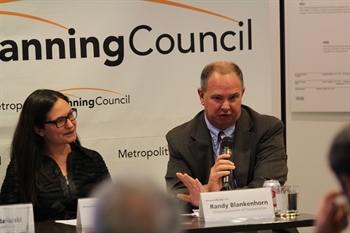Last week I drove from Chicago to the suburbs for a meeting. I budgeted one and a half hours for the trip because you never know if there is going to be a crash or major traffic nightmare. I got there half an hour early and had to kill some time in the cafeteria. But I really could have used an extra half hour of sleep that morning instead of having to plan for a worst-case travel scenario.
Our ability to travel around the region is getting increasingly challenging as transportation agencies struggle to keep up with maintaining the roads, rails, bike lanes, sidewalks and buses. And traffic congestion seems to just get worse. Billions of taxpayer dollars are being spent on transportation every year—but are we getting the results we want?
How do our transportation agencies choose what to fund? Who decides if we build an extra lane of highway, dedicated bus lane, bike lanes or sidewalks? How do we know if we are spending our transportation funds effectively?
Yes, historically politics has played a major role. However, since each year it seems we have less and less transportation funding available, now is the time to really start asking questions and paying attention. We should be using a better system than politics to make sure that billions of tax dollars are moving us toward goals such as improved safety, increased transportation choices, and better access to where we want to go.
The process to make more transparent, data-driven transportation decisions is called performance-based planning. This means using data and criteria to prioritize projects according to desired transportation goals. It is only logical that projects be evaluated in a consistent manner using performance measures so they can be easily compared against each other.

Transportation for America's Beth Osborne and Illinois Department of Transportation Secretary Randy Blankenhorn
At the MPC Roundtable on May 8, Getting Smarter on Transportation, we heard about this topic from Illinois Secretary of Transportation Randy Blankenhorn who announced a new process for evaluating transportation projects, Transportation for America Director of Technical Assistance Beth Osborne provided context on Federal performance-based planning requirements and best practice examples from other states, and Corporate Vice President of Motorola Solutions John Kedzierski had some examples of how it’s done in the private sector.
The Federal government has given us a push in this direction. As Osborne noted, the last two Federal transportation authorizations, Moving Ahead for Progress in the 21st Century (MAP-21) and Fixing America’s Surface Transportation Act (FAST Act) had a strong orientation toward performance-based planning. MAP-21 established seven national goal areas and required that states and metropolitan areas set targets for a range of performance measures.
For each of the federally required goal areas states must use performance measures and set targets. For example, in the area of safety, states must set targets for the number and rate of all motor vehicle fatalities and serious injuries as well as for bicycle and pedestrian fatalities and serious injuries. What this means is that states are required to make sure how they spend their limited transportation money is moving them in the right direction toward actually reducing fatalities and serious injuries.
At the roundtable, IDOT Secretary Randy Blankenhorn presented the agency’s new tool to help prioritize projects using a set of criteria aligned with state transportation goals—a major advance in helping the state use its limited resources most effectively and taking politics out of the process. While only to be used on new capacity at the start, the plan is to continue to evolve the process and use it for all modernization projects as well.
Having previously served at USDOT, as well as helping states work through implementation, Beth Osborne explained how different states are approaching performance based metrics. Tennessee is using their metrics to work through a backlog of projects. By carefully defining the goal of a project, and developing solutions that get most of the benefits for much less cost they are able to make more projects happen than in the past. Virginia, one of the best examples of such program, boasts that it has taken the politics out of transportation. The state meets with every project sponsor whose project is not funded and explains why, which is resulting in progressively better project submissions each year.
Kedzierski’s wisdom for the path ahead was that with data driven decisions—the key part is the decision. You need to say no in order to say yes to the right projects. It is also critical that everyone constantly revisit the goal. Everyone from leadership to the front lines must be working toward the same goals. That is how you get projects that deliver the results you want.
Watch Now
MPC thanks Lead Sponsor Edelman and Friend Sponsor CH2M for their generous sponsorship of this event.